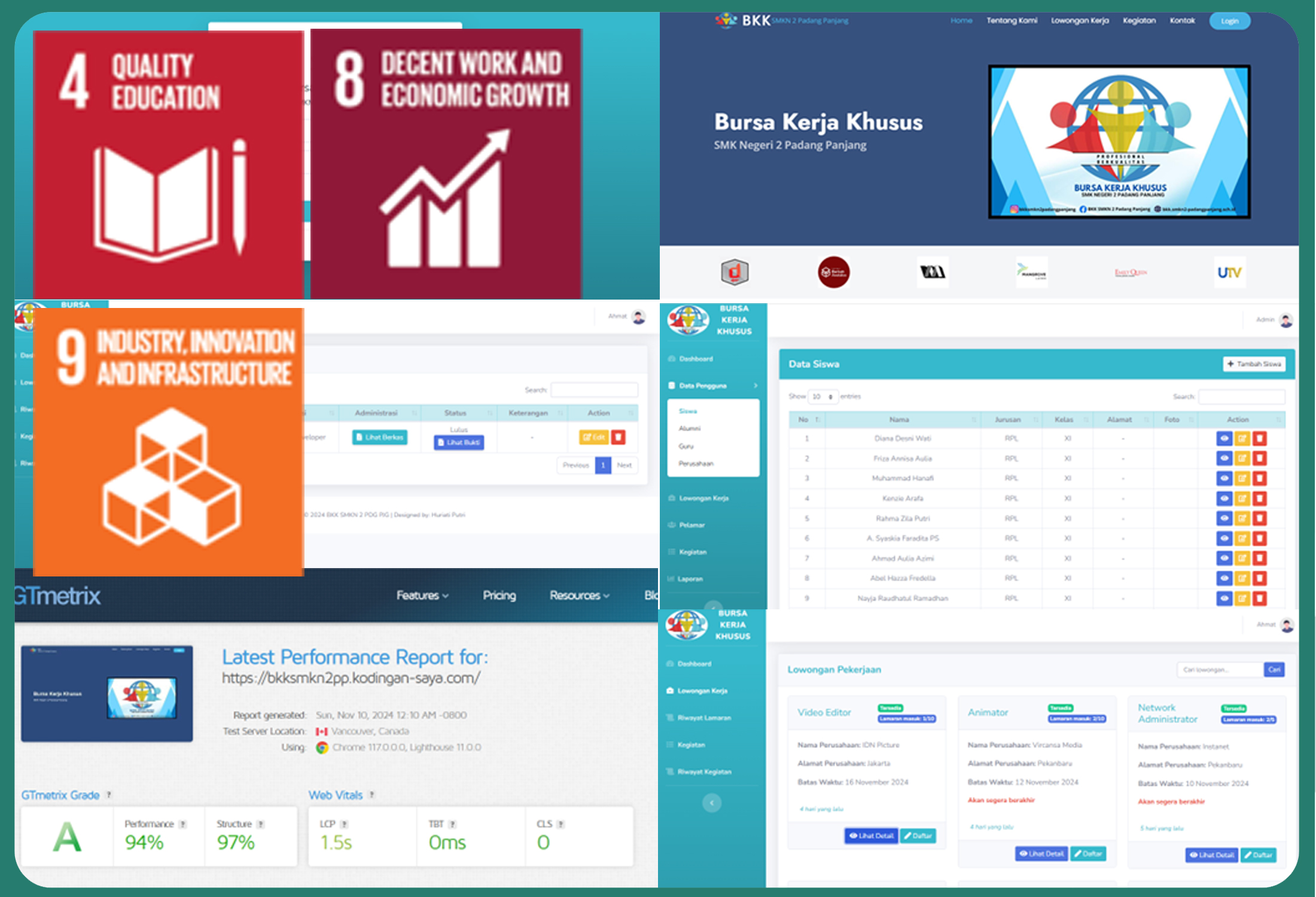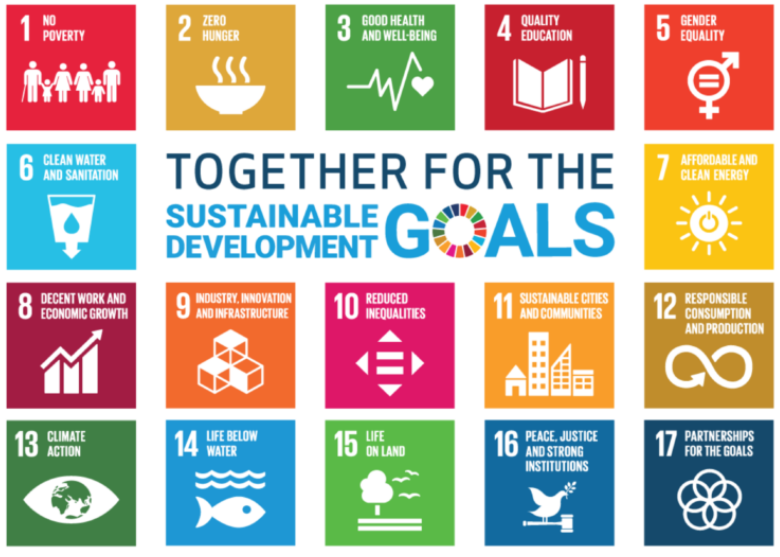Design and Development of a Targeted Job Fair Information System for Vocational Education
DOI:
https://doi.org/10.24036/javit.v5i2.248Keywords:
Information System, Special Job Fair, Prototype Model, Vocational Education, GTMetrixAbstract
The increasing demand for effective school-to-work transition mechanisms in vocational education highlights the need for integrated digital platforms. At State Vocational High School 2 Padang Panjang, the dissemination of job vacancy information and alumni data management remains manual, fragmented, and inefficient. Traditional communication channels, such as WhatsApp groups and direct phone calls, often fail to reach all alumni, while data collection via Google Forms lacks automation, scalability, and security. To address these challenges, this study developed a web-based Special Job Fair Information System using the Prototype development model. The system was implemented using the Laravel framework and MySQL database, allowing for real-time data management, secure job vacancy submissions, automated alumni tracking, and dynamic report generation. Performance testing using GTMetrix demonstrated strong system reliability, with a performance score of 94%, structure score of 97%, and favorable metrics including 1.5 seconds for Largest Contentful Paint (LCP), 0 milliseconds Total Blocking Time (TBT), and a Cumulative Layout Shift (CLS) score of 0. These results indicate a fast, stable, and responsive user experience. The system offers a scalable solution for improving graduate employability services in vocational education institutions, particularly in resource-constrained environments.
Downloads
References
M. Alenezi, S. Wardat, and M. Akour, “The Need of Integrating Digital Education in Higher Education: Challenges and Opportunities,” Sustain., vol. 15, no. 6, p. 4782, Mar. 2023, https://doi.org/10.3390/su15064782.
H. Harini, A. J. H. Ripki, S. Sulistianingsih, H. Herlina, and A. Putri, “Digital Transformation: The Utilization of Information and Communication Technology to Enhance Educational Management Efficiency in the Modern Era,” J. Minfo Polgan, vol. 13, no. 2, pp. 1668–1674, Oct. 2024, https://doi.org/10.33395/JMP.V13I2.14195.
S. Urath, “Stepping into the Digital Era: Transformation of School Administration Efficiency and Educational Management through the Role of Information Technology,” Indo-MathEdu Intellectuals J., vol. 5, no. 2, pp. 2009–2020, May 2024, https://doi.org/10.54373/IMEIJ.V5I2.1004.
M. Alenezi, “Digital Learning and Digital Institution in Higher Education,” Educ. Sci., vol. 13, no. 1, p. 88, Jan. 2023, https://doi.org/10.3390/educsci13010088.
A. Huda, Firdaus, D. Irfan, Y. Hendriyani, Almasri, and M. Sukmawati, “Optimizing Educational Assessment: The Practicality of Computer Adaptive Testing (CAT) with an Item Response Theory (IRT) Approach,” Int. J. Informatics Vis., vol. 8, no. 1, pp. 473–480, Mar. 2024, https://doi.org/10.62527/joiv.8.1.2217.
R. Halkhoree, M. Santally, O. Gukhool, and A. P. Murdan, “A Review of the Digital Transformation Landscape in Higher Education Institutions,” 1st Int. Conf. Smart Energy Syst. Artif. Intell. SESAI 2024, 2024, https://doi.org/10.1109/SESAI61023.2024.10599412.
P. S. Aithal, S. Prabhu, and S. Aithal, “Future of Higher Education through Technology Prediction and Forecasting,” SSRN Electron. J., Jul. 2024, https://doi.org/10.2139/ssrn.4901474.
M. Ul Hassan, A. Murtaza, and K. Rashid, “Redefining Higher Education Institutions (HEIs) in the Era of Globalisation and Global Crises: A Proposal for Future Sustainability,” Eur. J. Educ., vol. 60, no. 1, p. e12822, Mar. 2024, https://doi.org/10.1111/ejed.12822.
A. Rahman, W. D. A. Zebua, E. Satispi, and A. A. Kusuma, “Policy Formulation in Integrating Vocational Education Graduates with the Labor Market in Indonesia,” J. Stud. Pemerintah., vol. 12, no. 3, pp. 331–371, Nov. 2021, https://doi.org/10.18196/jgp.123141.
R. T. Amalia and H. F. O. von Korflesch, Entrepreneurship education in indonesian higher education: mapping literature from the country’s perspective, vol. 4, no. 3. Springer Singapore, 2021. https://doi.org/10.1007/s41959-021-00053-9.
et al., “Analysis of vocational education curriculum in ASEAN Economic Community: a literature review,” J. Soc. Humanit. Educ., vol. 1, no. 3, pp. 157–170, May 2021, https://doi.org/10.35912/jshe.v1i3.357.
L. Li, “Reskilling and Upskilling the Future-ready Workforce for Industry 4.0 and Beyond,” Inf. Syst. Front., vol. 26, no. 5, pp. 1697–1712, Oct. 2022, https://doi.org/10.1007/s10796-022-10308-y.
M. Poláková, J. H. Suleimanová, P. Madzík, L. Copuš, I. Molnárová, and J. Polednová, “Soft skills and their importance in the labour market under the conditions of Industry 5.0,” Heliyon, vol. 9, no. 8, Aug. 2023, https://doi.org/10.1016/j.heliyon.2023.e18670.
J. Mondolo, “The composite link between technological change and employment: A survey of the literature,” J. Econ. Surv., vol. 36, no. 4, pp. 1027–1068, Sep. 2022, https://doi.org/10.1111/joes.12469.
D. Jackson and I. Li, “Transition to work, mismatch and underemployment among graduates: an Australian longitudinal study,” Int. J. Manpow., vol. 43, no. 7, pp. 1516–1539, Dec. 2022, https://doi.org/10.1108/IJM-03-2021-0195.
C. Albert, M. A. Davia, and N. Legazpe, “Educational mismatch in recent university graduates. The role of labour mobility,” J. Youth Stud., vol. 26, no. 1, pp. 113–135, Jan. 2023, https://doi.org/10.1080/13676261.2021.1981840.
Z. S. Gea, T. Zulyadi, and N. Nurfahmi, “The Effectiveness Of The Role of The Special Job Fair SMK SMTI Banda Aceh in Enhancing Graduates Employability to The Business/Industry World,” J. Peurawi Media Kaji. Komun. Islam, vol. 5, no. 1, p. 51, Apr. 2022, https://doi.org/10.22373/jp.v5i1.12160.
E. H. Andriansyah and P. U. Kamalia, “National Standards of Education affect the employment opportunities of vocational high school graduates,” J. Pendidik. Vokasi, vol. 11, no. 2, pp. 112–124, Dec. 2021, https://doi.org/10.21831/jpv.v11i2.40791.
L. Aini, “The Role of Bursa Kerja Khusu (BKK) in Assisting The Absorption of Graduates Employment,” Econ. Educ. Anal. J., vol. 10, no. 1, pp. 25–40, Mar. 2021, https://doi.org/10.15294/EEAJ.V10I1.44205.
F. V. Arie, “Enhancing the Sustainability of Higher Education in Indonesia: A Six-Sigma Approach.” 2025. Accessed: Jul. 03, 2025. [Online]. Available: https://hdl.handle.net/2437/390424.
M. O. Faruque, T. Talukder, M. N. Pranto, A. Debnath, and S. Sultana, “The Rise of Remote Work and Its Impact on Small Businesses,” Am. J. Ind. Bus. Manag., vol. 14, no. 06, pp. 869–890, Jun. 2024, https://doi.org/10.4236/ajibm.2024.146044.
S. Dart and S. Cunningham, “Using Institutional Data to Drive Quality, Improvement, and Innovation,” pp. 1–24, 2023, https://doi.org/10.1007/978-981-19-9438-8_29-1.
C. S. Octiva, Israkwaty, U. W. Nuryanto, H. Eldo, and A. Tahir, “Application of Holt-Winter Exponential Smoothing Method to Design a Drug Inventory Prediction Application in Private Health Units,” J. Inf. dan Teknol., pp. 1–6, Jan. 2024, https://doi.org/10.60083/jidt.v6i1.464.
S. Dharwiyanti and R. S. Wahono, “Pengantar Unified Modeling Language (UML), http://www. ilmukomputer. com,” Diakses tanggal, pp. 1–13, 2003.
A. Noviantoro, A. B. Silviana, R. R. Fitriani, and H. P. Permatasari, “Rancangan Dan Implementasi Aplikasi Sewa Lapangan Badminton Wilayah Depok Berbasis Web,” J. Tek. dan Sci., vol. 1, no. 2, pp. 88–103, 2022, https://doi.org/10.56127/jts.v1i2.108.
R. Widyastuti, “Penerapan Sistem Informasi Akademik Di Smk Yaspen Jakarta,” PROSISKO J. Pengemb. Ris. dan Obs. Sist. Komput., vol. 9, no. 2, pp. 9–24, 2022, https://doi.org/10.30656/prosisko.v9i2.4938.
R. N. Bija, A. P. Talaohu, and A. Munandar, “Analisis Kualitas Website Bursa Efek Indonesia Dengan Menggunakan Metode Gtmetrix,” Sci. J. Reflect. Econ. Accounting, Manag. Bus., vol. 7, no. 2, pp. 554–561, 2024, https://doi.org/10.37481/sjr.v7i2.850.
A. M. Andrian, N. K. Khamis, A. Subbiah, H. Zuhriyah, and S. Faizah, “Revolutionizing Recruitment Management: Optimizing Advanced Digital Solutions for Manpower Planning in Higher Education,” Proc. IEEE Conf. Syst. Process Control. ICSPC, no. 2024, pp. 89–94, 2024, https://doi.org/10.1109/ICSPC63060.2024.10862166.
H. E. Ajaju, U. B. Egwuagu, and N. H. Anikeze, “The Effect of Digital Tools Enhanced Recruitment and Selection Processes on Organizational Performance with focus on National Research Institutes in South East Nigeria,” Caritas J. Manag. Soc. Sci. Humanit., vol. 3, no. 1, Sep. 2024, Accessed: Jul. 03, 2025. [Online]. Available: https://caritasuniversityjournals.org/index.php/cjmssh/article/view/98.
H. Crompton and D. Burke, “Artificial intelligence in higher education: the state of the field,” Int. J. Educ. Technol. High. Educ., vol. 20, no. 1, pp. 1–22, Dec. 2023, https://doi.org/10.1186/S41239-023-00392-8.
M. Ibrahim, N. Khairudin, and D. Salleh, “Enhancing interactive environment with applied of scenario based approach via EDpuzzle adoption,” AIP Conf. Proc., vol. 2608, no. 1, Jun. 2023, https://doi.org/10.1063/5.0145367.
V. de Campos, J. M. N. David, V. Ströele, and R. Braga, “Aligning technical knowledge to an industry domain in global software development: A systematic mapping,” J. Softw. Evol. Process, vol. 36, no. 12, p. e2713, Dec. 2024, https://doi.org/10.1002/smr.2713.
A. M. Ștefan, N. R. Rusu, E. Ovreiu, and M. Ciuc, “Empowering Healthcare: A Comprehensive Guide to Implementing a Robust Medical Information System—Components, Benefits, Objectives, Evaluation Criteria, and Seamless Deployment Strategies,” Appl. Syst. Innov., vol. 7, no. 3, p. 51, Jun. 2024, https://doi.org/10.3390/asi7030051.
A. Pradhan, M. Year, and R. Moser, “Employee – Job profile matching challenges: AI/ML-based recommender systems solutions for knowledge workers,” Mar. 2024, https://doi.org/10.25949/25440139.V1.

Downloads
Published
How to Cite
Issue
Section
License
Copyright (c) 2025 Huriati Putri, Resmi Darni, Lativa Mursyida, Rizkayeni Marta

This work is licensed under a Creative Commons Attribution 4.0 International License.










